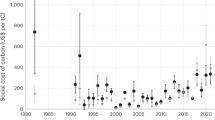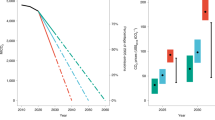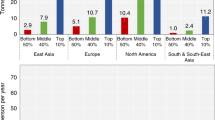Abstract
The social cost of carbon (SCC) is a commonly employed metric of the expected economic damages from carbon dioxide (CO2) emissions. Although useful in an optimal policy context, a world-level approach obscures the heterogeneous geography of climate damage and vast differences in country-level contributions to the global SCC, as well as climate and socio-economic uncertainties, which are larger at the regional level. Here we estimate country-level contributions to the SCC using recent climate model projections, empirical climate-driven economic damage estimations and socio-economic projections. Central specifications show high global SCC values (median, US$417 per tonne of CO2 (tCO2); 66% confidence intervals, US$177–805 per tCO2) and a country-level SCC that is unequally distributed. However, the relative ranking of countries is robust to different specifications: countries that incur large fractions of the global cost consistently include India, China, Saudi Arabia and the United States.
This is a preview of subscription content, access via your institution
Access options
Access Nature and 54 other Nature Portfolio journals
Get Nature+, our best-value online-access subscription
$29.99 / 30 days
cancel any time
Subscribe to this journal
Receive 12 print issues and online access
$209.00 per year
only $17.42 per issue
Buy this article
- Purchase on Springer Link
- Instant access to full article PDF
Prices may be subject to local taxes which are calculated during checkout




Similar content being viewed by others
Data availability
The database of the CSCCs with uncertainty bounds under all scenarios, model specifications and discounting schemes is available as a part of the Supplementary Information and via https://country-level-scc.github.io/.
Change history
25 March 2019
In the version of this Article originally published, owing to a code error, the CSCC values for all income-dependent (that is, rich-poor) impact model specifications were incorrect, showing higher values relative to the preferred model rather than lower. These have now been recalculated for BHM SR RP, BHM LR RP and DJO RP, and Figs 1, 2b and 3b, as well as Supplementary Figs 2, 4–6 and 9, have been updated to reflect these recalculations. In addition, the text reading, “The GSCC tends to be similar in both pooled and rich/poor specifications of the damages model, with the exception of SSP3, in which the estimated GSCC is much higher in the rich/poor specifications. The DJO specification of the economic impact function yields significantly higher GSCC values” has been modified to reflect this recalculation and now reads, “The GSCC is always lower using the rich/poor specifications of the damages model with confidence intervals that, in most cases, extend into the negative SCC range. The DJO specification of the economic impact function, which also estimates distinct effects for rich and poor countries, yields significantly lower GSCC values.” The sentence beginning, “This results in higher (almost twice as much) global values of the SCC...” has also been modified to “In the case of the LR BHM specifications, this results in higher (almost twice as much) global values of the SCC...” The income thresholds and coefficients in the Supplementary Text, as well as the interpretation of the DJO sensitivity analysis results, have also been updated to reflect these changes. The authors thank Yixuan Zheng for identifying the code error.
References
Tol, R. S. J. The social cost of carbon. Annu. Rev. Resour. Econ. 3, 419–443 (2011).
IAWG Technical Update of the Social Cost of Carbon for Regulatory Impact Analysis Under Executive Order 12866 (US Government, 2013).
Pindyck, R. S. The Social Cost of Carbon Revisited (National Bureau of Economic Research, 2016).
Anthoff, D. & Tol, R. S. J. The uncertainty about the social cost of carbon: a decomposition analysis using fund. Climatic Change 117, 515–530 (2013).
Moore, F. C. & Diaz, D. B. Temperature impacts on economic growth warrant stringent mitigation policy. Nat. Clim. Change 5, 127–131 (2015).
Nordhaus, W. Estimates of the social cost of carbon: concepts and results from the DICE-2013R model and alternative approaches. J. Assoc. Environ. Resour. Econ. 1, 273–312 (2014).
Bansal, R., Kiku, D. & Ochoa, M. Price of Long-Run Temperature Shifts in Capital Markets (National Bureau of Economic Research, 2016).
National Academies of Sciences, Engineering and Medicine Valuing Climate Damages: Updating Estimation of the Social Cost of Carbon Dioxide (National Academies, Washington, 2017).
Anthoff, D., Tol, R. S. J. & Yohe, G. W. Risk aversion, time preference, and the social cost of carbon. Environ. Res. Lett. 4, 024002 (2009).
Weitzman, M. L. Tail-hedge discounting and the social cost of carbon. J. Econ. Lit. 51, 873–882 (2013).
Ackerman, F. & Stanton, E. A. Climate risks and carbon prices: revising the social cost of carbon. Economics 6, 2012–10 (2012).
Hope, C. Discount rates, equity weights and the social cost of carbon. Energy Econ. 30, 1011–1019 (2008).
Cai, Y., Judd, K. L. & Lontzek, T. S. The social cost of carbon with economic and climate risks. Preprint at http://arXiv.org/q-fin.EC/150406909 (2015).
Adler, M. et al. Priority for the worse-off and the social cost of carbon. Nat. Clim. Change 7, 443–449 (2017).
Moyer, E., Woolley, M., Glotter, M. & Weisbach, D. Climate Impacts on Economic Growth as Drivers of Uncertainty in the Social Cost of Carbon Working Paper No. 65 (Coase-Sandor Institute for Law & Economics, 2013).
Kopp, R. E., Golub, A., Keohane, N. O. & Onda, C. The influence of the specification of climate change damages on the social cost of carbon. Economics 6, 2012–13 (2012).
Nordhaus, W. Estimates of the social cost of carbon: concepts and results from the DICE-2013R model and alternative approaches. J. Assoc. Environ. Resour. Econ. 1, 273–312 (2014).
Cai, Y., Judd, K. L. & Lontzek, T. S. The Social Cost of Stochastic and Irreversible Climate Change (National Bureau of Economic Research, 2013).
Barrett, S. Self-enforcing international environmental agreements. Oxf. Econ. Pap. 46, 878–894 (1994).
Carraro, C. & Siniscalco, D. Strategies for the international protection of the environment. J. Public Econ. 52, 309–328 (1993).
Adams, R. M., McCarl, B. A. & Mearns, L. O. in Issues in the Impacts of Climate Variability and Change on Agriculture (ed. Mearns, L. O.) 131–148 (Springer Netherlands, Dordrecht, 2003).
Pizer, W. et al. Using and improving the social cost of carbon. Science 346, 1189–1190 (2014).
Nordhaus, W. D. Revisiting the social cost of carbon. Proc. Natl Acad. Sci. USA 114, 1518–1523 (2017).
O’Neill, B. C. et al. A new scenario framework for climate change research: the concept of shared socioeconomic pathways. Climatic Change 122, 387–400 (2013).
Riahi, K. et al. The shared socioeconomic pathways and their energy, land use, and greenhouse gas emissions implications: an overview. Glob. Environ. Change 42, 153–168 (2017).
Moss, R. H. et al. The next generation of scenarios for climate change research and assessment. Nature 463, 747–756 (2010).
Taylor, K. E., Stouffer, R. J. & Meehl, G. A. An overview of CMIP5 and the experiment design. Bull. Am. Meteorol. Soc. 93, 485–498 (2012).
Joos, F. et al. Carbon dioxide and climate impulse response functions for the computation of greenhouse gas metrics: a multi-model analysis. Atmos. Chem. Phys. 13, 2793–2825 (2013).
Ricke, K. L. & Caldeira, K. Maximum warming occurs about one decade after a carbon dioxide emission. Environ. Res. Lett. 9, 124002 (2014).
Burke, M., Hsiang, S. M. & Miguel, E. Global non-linear effect of temperature on economic production. Nature 527, 235–239 (2015).
Dell, M., Jones, B. F. & Olken, B. A. Temperature shocks and economic growth: evidence from the last half century. Am. Econ. J. Macroecon. 4, 66–95 (2012).
Diaz, D. & Moore, F. Quantifying the economic risks of climate change. Nat. Clim. Change 7, 774–782 (2017).
Jones, C. I. & Klenow, P. J. Beyond GDP? Welfare across countries and time. Am. Econ. Rev. 106, 2426–2457 (2016).
Guo, J., Hepburn, C., Tol, R. S. J. & Anthoff, D. Discounting and the social cost of carbon: a closer look at uncertainty. Environ. Sci. Policy 9, 205–216 (2006).
Ramsey, F. P. A mathematical theory of saving. Econ. J. 38, 543–559 (1928).
Lemoine, D. & Kapnick, S. A top-down approach to projecting market impacts of climate change. Nat. Clim. Change 6, 51–55 (2016).
Burke, M., Davis, W. M. & Diffenbaugh, N. S. Large potential reduction in economic damages under UN mitigation targets. Nature 557, 549–553 (2018).
Gastwirth, J. L. The estimation of the Lorenz curve and Gini index. Rev. Econ. Stat. 54, 306–316 (1972).
Raffinetti, E., Siletti, E. & Vernizzi, A. On the Gini coefficient normalization when attributes with negative values are considered. Stat. Methods Appl. 24, 507–521 (2015).
Oh, C. H. & Reuveny, R. Climatic natural disasters, political risk, and international trade. Glob. Environ. Change 20, 243–254 (2010).
Bohra-Mishra, P., Oppenheimer, M. & Hsiang, S. M. Nonlinear permanent migration response to climatic variations but minimal response to disasters. Proc. Natl Acad. Sci. USA 111, 9780–9785 (2014).
Thornton, J. & Covington, H. Climate change before the court. Nat. Geosci. 9, 3–5 (2016).
Rao, S. et al. A multi-model assessment of the co-benefits of climate mitigation for global air quality. Environ. Res. Lett. 11, 124013 (2016).
Pindyck, R. S. Climate change policy: what do the models tell us? J. Econ. Lit. 51, 860–872 (2013).
Lempert, R. J. Shaping the Next One Hundred Years: New Methods for Quantitative, Long-Term Policy Analysis (Rand Corporation, 2003).
Matsuura, K. & Willmott, C. Terrestrial Air Temperature and Precipitation: 1900–2006 Gridded Monthly Time Series Version 1.01 (Univ. Delaware, 2007); http://climate.geog.udel.edu/~climate/
Acknowledgements
M.T. thanks M. Burke for an early discussion of these ideas and about the climate impact functions. K.R. thanks C. McIntosh and J. Moreno-Cruz for helpful discussions during the revisions of this manuscript. M.T. received funding from the European Research Council under the European Union’s Seventh Framework Programme (FP7/2007-2013)/ERC grant agreement no. 336155 (project COBHAM). L.D received funding from the EU’s Horizon 2020 research and innovation programme under grant agreement no. 642147 (CD-LINKS).
Author information
Authors and Affiliations
Contributions
M.T. conceived the study. K.R. performed the climate data analysis. L.D. replicated the economic damage functions and performed the CSCC calculations and uncertainty analysis. K.R., M.T. and L.D. analysed the results. K.R. and M.T. wrote the manuscript. All authors discussed the results and provided input on the manuscript.
Corresponding author
Ethics declarations
Competing interests
The authors declare no competing interests.
Additional information
Publisher’s note: Springer Nature remains neutral with regard to jurisdictional claims in published maps and institutional affiliations.
Supplementary Information
Supplementary Information
Supplementary Discussion, Supplementary Figures 1–13, Supplementary Tables 1–6, Supplementary References
Supplementary Data 1
CSCC Database
Supplementary Data 2
CSCC Database Readme
Rights and permissions
About this article
Cite this article
Ricke, K., Drouet, L., Caldeira, K. et al. Country-level social cost of carbon. Nature Clim Change 8, 895–900 (2018). https://doi.org/10.1038/s41558-018-0282-y
Received:
Accepted:
Published:
Issue Date:
DOI: https://doi.org/10.1038/s41558-018-0282-y
This article is cited by
-
Going beyond averages
Nature Climate Change (2024)
-
Carbonservation with Demonstrated Biodiversity and Carbon Gains: Carbon Can Pay But Biodiversity Must Lead
Environmental Management (2024)
-
Measuring the synergy of air pollution and CO2 emission in Chinese urban agglomerations: an evaluation from the aggregate impact and correlation perspectives
Stochastic Environmental Research and Risk Assessment (2024)
-
Damage function uncertainty increases the social cost of methane and nitrous oxide
Nature Climate Change (2023)
-
Climate co-benefits of tiger conservation
Nature Ecology & Evolution (2023)



